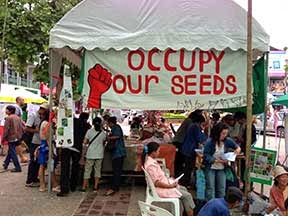Pun Pun gets a variety of seeds from around the world from people who willingly send or bring seeds to the farm. Recall one of Pun Pun's missions is to cultivate a wide variety of seeds to save them, thus enhancing biodiversity. Today's cash crop farms grow only a few strains, and only a few large-scale mega suppliers encourage the planting of their products - at a profit - and control a large amount of food production world-wide. The problem with such a system where farmers are dependent on seed from such suppliers is that should something happen to the strain they supply, food production in the world will grind to a halt. Pun Pun encourages farmers to cultivate a wide range of seeds that grow well in their farm conditions , and not be dependent solely on suppliers of seed to produce food. After all, if you look at nature, there are many millions of forms of life on this planet. By narrowing the gene pool down to a few is counter what nature does. Fecundity, diversity and change is what nature is about, and in this spirit, Pun Pun farm emulates biodiversity for the benefit of future generations of farmers.
Many seeds are tried out at Pun Pun to see if they grow or not in the climate here in northern Thailand; some work and some do not. It's a matter of experimenting with them. That is what makes Pun Pun a lot of fun - try things out for ourselves to observe what happens, take note of what the outcome is, and try again.
When we interns first arrived, the second day being here we had the task to put seeds into trays to cultivate sprouts. Once the plants sprouted, we replanted them into beds we prepared in a field on the farm. We sprouted rice, wheat, rye, kamut, several varieties of lettuce and cabbage, and tomatoes. Below is the photo step by step account.
Sprouting Seeds and Planting
First we prepared sprout trays for the seeds. We found some soil that was not too sandy nor contained too much clay - it's important to allow the seedlings to penetrate the soil with their roots and also easy to take out once they sprouted and were ready for replanting. To the soil we mixed chicken poop as fertilizer, to boost growth of the sprouts. We filled the trays with soil and chicken poop (about half and half carefully mixed) and then put seeds into the trays. Each tray was labelled and noted for what type of plant was contained.
 |
| September 2. Trays prepared and planted with seeds. |
 |
| September 5. Sprouts! |
 |
| September 7. Sprouts really growing tall. |
 |
| September 8. Rice almost ready for replanting. |
 |
September 8. Two leaves come out first
which provide nourishment for lettuce. |
 |
| September 12. Time to replant wheat, rye and kamut. |
 |
| Pi Jo carefully plants the sprouts. |
 |
| We interns pitch in. Faster, and fun to do this work! |
 |
| Pi Jo opening some compost to add to the plant beds. |
 |
| Spreading compost on the bed. |
 |
Spreading straw over compost and soil mix.
Straw inhibits weed growth and keeps the soil moist. |
 |
| Planting shoots in new bed. |
 |
| Pulling weeds around some climbing beans. |
 |
Putting sticks around the climbing beans
to act as a trellis. |
 |
| Everyone pitching in to allow beans to climb. |
In a few weeks I'll write more on the progress of our plants.


























































